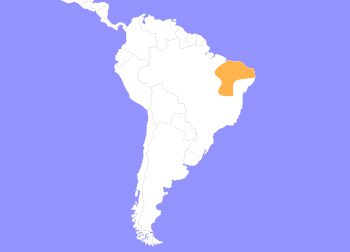Jenday Conure
Aratinga jandaya
The jenday conure is a small Neotropical parrot described as having green wings and tail, a reddish-orange body, yellow head and neck and orange cheeks. They are native to wooded habitats in northeastern Brazil. It is a member of the Aratinga solstitialis complex of parakeets very closely related to, and possibly subspecies of the sun parakeet. They are more commonly known as the jandaya parakeet in their native region.
The bird has a wide range, but is locally rare in the wild; they are common in aviculture, where they are known as "jenday conures". On average it measures 12 in. in length and weighs 125–140 gm. In the wild, their diet consists of various fruits including mango, cashew apples, as well as palm nuts. They also consume plants cultivated by humans such as rice and maize, which makes local farmers consider them a pest. Things that are toxic to jandaya parakeets include chocolate, caffeine, and a chemical often found in avocados.
The jandaya parakeet has a very loud, shrill call. It has an extremely large range in northeastern Brazil in the states of Piaui, Maranhao, Tocantins, and Ceara, and portions of Pará. It is found in lowland inhabiting woodland and palm groves. Jandaya parakeets nest in tree hollows, typically choosing a location at least 50 feet from the ground.In captivity, the hen lays three to six eggs, which she then incubates for roughly 26 days. The young are fed by both parents, and fledge after two months.

Jenday Conures are native to the wooded habitats of northeastern Brazil.
HABITAT -They inhabit woodland and palm groves of Brazil.
DIET -In the wild they will eat mango, cashew apples, palm nuts, rice, and maize.
FUN FACT -Conures have a tendency to spend long periods of time in their nest, even when not breeding.
SOCIAL BEHAVIOR -They aren’t known to be a truly social bird, they do form pairs and small groups seen feeding together.
ACTIVITY -They are diurnal being most active during the day and resting during the evening.
PREDATORS -Predators include birds of prey, snakes, and terrestrial mammals that attack fledglings and eggs.
SIZE -On average it measures 12 in. in length and weighs 125–140 gm.
RELATIVES -Jenday conures are thought to be related to Sun Parakeets, and the closest relative to the now extinct Carolina parakeet.
CONSERVATION -Jenday conures are categorized as LC (Least Concern) by the IUCN.
Cub Creek Animal Care Information
Housing - Our Jenday Conure is currently housed in special multi-species habitat enclosure that is bedded with pine shavings for easier clean up. This enclosure contains several trees and perches, as well as nest boxes and plenty of natural light.
Diet - Our conures are fed ZuPreem FruitBlend medium bird pellets that give them all the vitamins and nutrients they need to be healthy. They also get fresh bird salad daily, which includes apple, shredded sweet potato, and greens. They are also given access to fresh water daily.
Enrichment - Living in a multi-species enclosure provides enrichment through daily interactions. Campers can use cardboard, twine, and pretty much anything we can find to make hanging toys that can have food hidden in them or just used to swing on!

